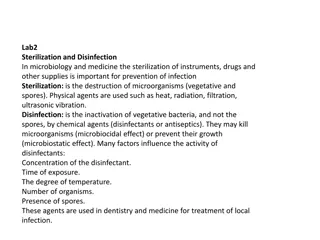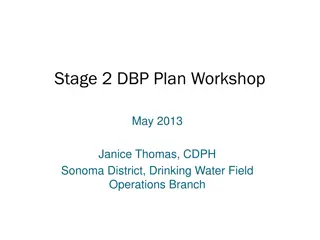Disinfection By-Products in Water Treatment
In this detailed overview, you will learn about the precursors, factors, methods of disinfection, as well as the types of disinfectants used in water treatment. Discover how precursor concentrations, disinfection methods, water chemistry, and environmental factors contribute to the formation of disinfection by-products (DBPs). Explore the advantages and disadvantages of various disinfectants such as chlorine, ozone, and bromine in maintaining water safety. Gain insights into the impact of pH, temperature, and water age on DBP formation, and understand the importance of efficient disinfection practices to ensure safe drinking water for communities.
Download Presentation

Please find below an Image/Link to download the presentation.
The content on the website is provided AS IS for your information and personal use only. It may not be sold, licensed, or shared on other websites without obtaining consent from the author.If you encounter any issues during the download, it is possible that the publisher has removed the file from their server.
You are allowed to download the files provided on this website for personal or commercial use, subject to the condition that they are used lawfully. All files are the property of their respective owners.
The content on the website is provided AS IS for your information and personal use only. It may not be sold, licensed, or shared on other websites without obtaining consent from the author.
E N D
Presentation Transcript
Advancing the Science of Transformation in Integrated Primary Care: Informing Options for Scaling-up Innovation Session 3: Addressing health equity and disparities across diverse communities: Policy implications & Discussion Jonathan Foley, Westcott Partners LLC
Purpose Describe the use of certain indicators of need in a primary health care funding formula in the context of a comprehensive reform of New Zealand s primary health care system; and, Assess the impact of this funding approach on primary health care delivery systems and populations served by those systems Comment on the implications of New Zealand s experience to efforts to address social determinants in the United States
Context Primary Health Care Strategy comprehensive reform of the way primary health care was delivered, financed, and governed. Specific objectives included: Making primary health care affordable with co-pays reduced or, in some cases, eliminated Increasing utilization of needed services, especially preventive services and health screenings Promoting better coordination of care Reducing health inequalities through new models of care Primary Health Organizations (PHOs) GP practices and clinics aggregated in local areas to be focal point. Non-profit with community representation. Needs-based population funding formulae means for allocating government subsidy; incorporates ethnicity and area deprivation index
Health disparities Life Expectancy at Birth by Ethnicity and Gender, 1980-84, 1996-99 90 9.8 81.5 80.8 7.8 78.6 78.6 77.4 80 77.2 75.7 75.7 9.9 74.8 6.3 73.9 72.4 72.3 71 70.9 69.4 68.9 67.9 70 66.7 65.8 64.6 60 50 40 30 20 10 0 Male Female Male Female 1980-84 1996-99 Maori Pacific All Other Low Income High Income New Zealand Ministry of Health, Decades of Disparity: Ethnic Mortality Trends in New Zealand 1980 1999, 2003 http://www.moh.govt.nz/notebook/nbbooks.nsf/0/37A7ABB191191FB9CC256DDA00064211/$file/EthnicMortalityTrends.pdf New Zealand Ministry of Health, Decades of Disparity II: Socioeconomic mortality trends in New Zealand, 1981-1999, 2005. http://www.rangahau.co.nz/assets//decades_disparity/disparities_report2.pdf, income is weighted by ethnicity.
Health Disparities (cont.) Percent of NZ Health Survey (2002/2003) respondents answering positively to selected questions (age standardized) Disease/ condition Gender Maori Pacific European/ other Asian Heart disease Male Female Male Female Male Female Male Female Male Female Male Female Male Female Male Female Male Female Male Female Female Female 13.6 10.6 2.5 2.8 9.5 6.7 21.6 27.2 6.0 6.3 23.7 23.9 15.9 12.0 29.0 27.5 42.9 51.1 67.8 82.5 69.0 72.8 5.9 7.9 n/a n/a 8.1 11.9 9.4 10.8 n/a n/a 16.2 18.2 9.5 11.1 38.0 47.8 34.8 31.6 75.1 83.7 57.1 54.4 9.4 8.5 2.0 1.4 3.4 2.4 20.8 25.9 4.6 5.9 17.6 19.2 14.6 13.2 18.0 19.8 21.3 19.9 77.7 87.0 76.9 77.5 8.1 4.6 n/a n/a 8.1 8.7 6.3 8.7 n/a n/a 14.4 13.1 13.4 12.3 4.3 6.9 18.9 3.6 63.8 73.8 55.6 43.1 Stroke Diabetes Asthma COPD High blood pressure High cholesterol Obesity Current Smoker Seen GP in last year Mammogram Cervical screen New Zealand Ministry of Health, A Portrait of Health: Key results of the 2002/03 New Zealand Health Survey, 2004 Http://www.moh.govt.nz
For the most recent version, see NZDep2013 Index of Deprivation, June Atkinson, Clare Salmond, and Peter Crampton, published by the Department of Public Health, University of Otago, Wellington, May, 2014. http://www.otago.ac.nz/wellington/otago069936.pdf
Health equity innovation Funding formulae allocate more money to PHOs with greater concentrations of Maori, Pacific Islanders, and most deprived enrollees PHOs use funding to: Lower fees for enrollees Develop outreach programs that improve access e.g., transportation services, nurse clinics on marae or remote locations, community health workers Run health promotion services and campaigns that influence health behaviors e.g., smoking cessation, safe driving, healthy eating Connected to mainstream medical care through PHO
Pacific women as keys to family health Culturally appropriate services Community based health promotion
Evaluation of impact Lower fees, especially for children, elderly and Access practices Increased utilization of primary and preventive services PHOs an established part of the delivery system Some reduction in health inequalities Evidence of innovations in service delivery
Lessons Learned Rapid implementation driven by political momentum enabled broad- based reform across the country; DHBs and general practitioners do not have as much ownership of strategy because of rapid implementation; Fee reductions limited by soft regulatory approach and GP resistance; Tensions between universal and targeted approaches; Not enough attention to planning and evaluating service delivery innovations aimed at reducing inequalities; Impact of service delivery innovations dependent on capacity and expertise of local practitioners.
Rapid Implementation Primary Health Care Funding Path PHOs and Enrolled Population 800 4.50 90 Cumulative in mill. 700 4.00 80 Enrolee count in millions Cumulative PHOs 3.50 70 600 Number of PHOs 3.00 60 500 $ million 2.50 50 2.00 40 400 1.50 30 300 1.00 20 200 0.50 10 - 0 100 Oct-02 Oct-03 Oct-04 Oct-05 Jul-02 Jan-03 Jul-03 Jan-04 Jul-04 Jan-05 Jul-05 Apr-03 Apr-04 Apr-05 0 02/03 Quarter 03/04 04/05 05/06 06/07 07/08 Base Low cost access Other
Implications for the United States Several versions of area deprivation indeces available strong correlation with health outcomes; use readily available Census data Existing and promising programs to address health inequalities through focus on social risk factors: Community health centers 1200 centers, 25 million served Patient Centered Medical Home comprehensive, coordinated, team approach Accountable Health Communities 44 communities IMPACT Act possible adjustments to Medicare payments based on social risk factors Scaling up depends on: Clearer understanding of what works Local capacity and expertise to undertake new models of care Appropriate funding Ongoing accountability mechanisms, evaluation and feedback Political will























